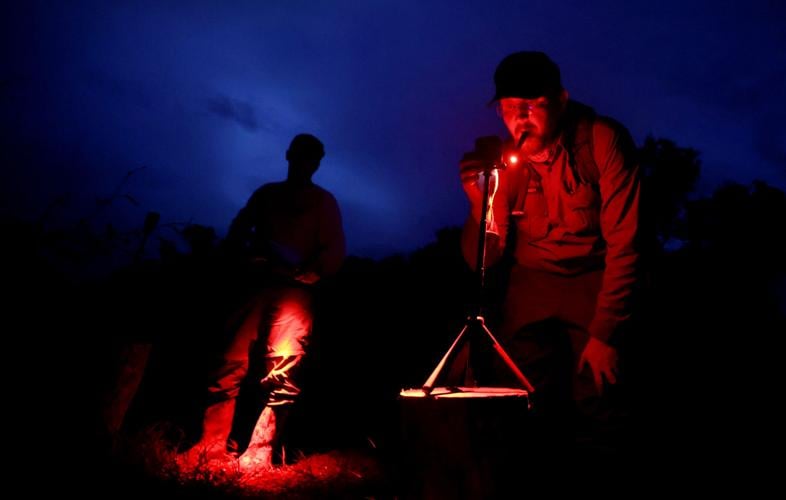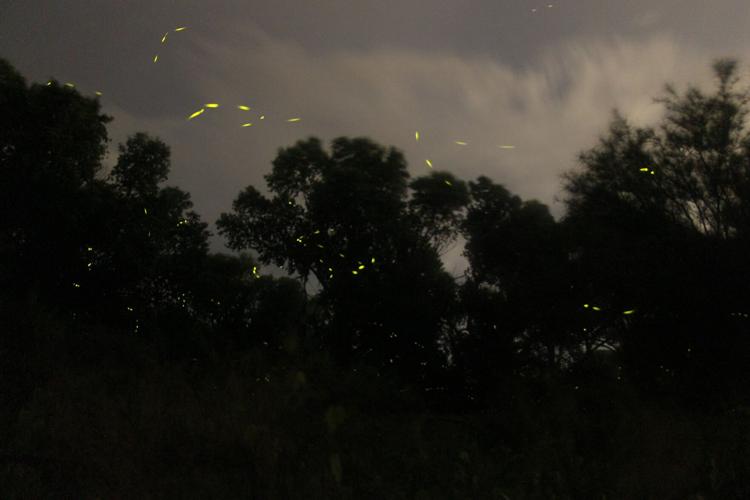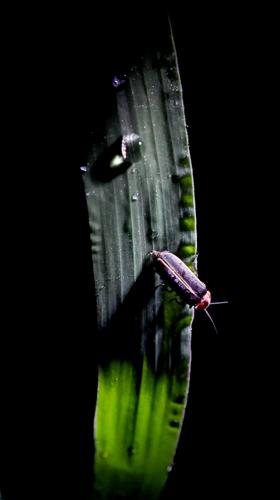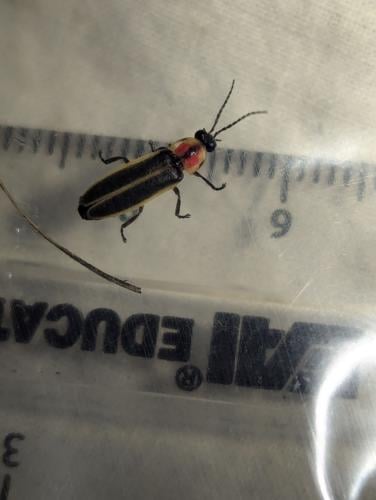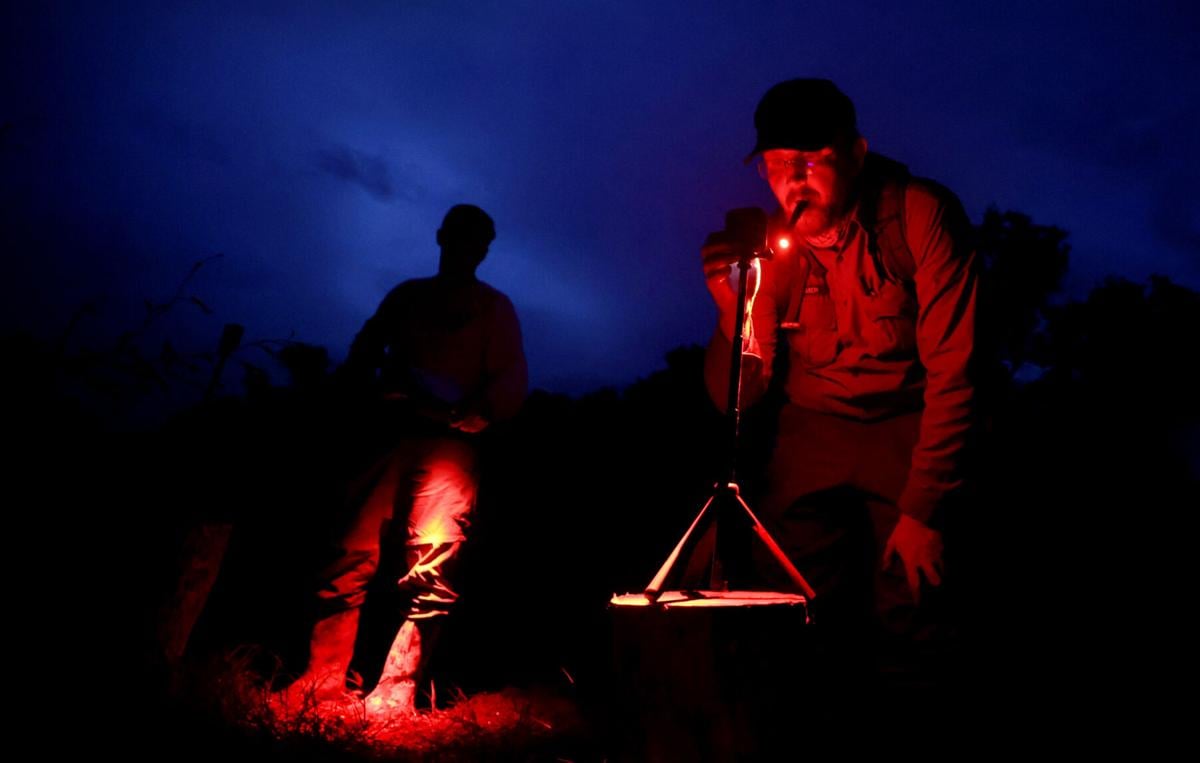Each year in late spring, the forest fills with fireflies that flash in unison at Great Smoky Mountains National Park.
The synchronous show draws so many spectators to eastern Tennessee that the park service has to hold a lottery to limit the number of vehicles in the area at the height of the annual mating display.
Saguaro National Park will probably never have that problem, but it does have its own small population of synchronous fireflies.
Park biologist Lucas Hetherington discovered the rare insects on July 11 at an isolated spot in the park’s Rincon Mountain District.
It was a place he had already checked earlier in the evening, but he decided to stop there again about 10 p.m. “As I pulled into the parking area, I could see little flashes off in the trees and got really excited,” Hetherington said. “I happened to be in the right place at the right time.”

A firefly makes its way along a leaf as a small team works to record data about the colony of fireflies living along the Santa Cruz river in Tumacacori National Historical Park, Tumacacori, Ariz., in August.
It’s pretty hard to keep track of flying bugs at night — even ones that flash yellow three times in quick succession and then go dark for six seconds or so — but he said he counted about 40 of the bugs in a roughly 500-square-foot area.
It marked the first documented sighting of Southwest synchronous fireflies within the park. During a follow-up survey recently, the bugs also were found at three other places along Rincon Creek and its tributaries.
“We suspected they were in Saguaro, but now we’ve confirmed it,” Hetherington said.
Into the unknown
The species, formally known as Photinus knulli, has previously been recorded at roughly a dozen scattered locations across southeastern Arizona and northern Mexico, mostly near Peña Blanca Lake and along the Santa Cruz River south of Tucson.
One of the largest populations can be found through late summer at Tumacacori National Historical Park.
The Southwest synchronous firefly is one of just three species in North America that is known to flash in unison.
Experts believe the insects could be more widespread than previously thought in the sky islands of Southern Arizona. They just haven’t been documented yet, because they only show up at night for a few weeks a year in remote locations.
“Most people don’t go out roaming around during the new moon with the mountain lions and the rattlesnakes,” said Tony Palmer, a biological science technician for the park service at Tumacacori.
But that’s exactly what Palmer was doing when he led a small park service crew down into the soggy floodplain of the Santa Cruz River, about 50 miles south of Tucson, to study the synchronous fireflies there.

Ranger Tony Palmer watches for firefly sign as the day ends over the Santa Cruz river in Tumacacori National Historical Park, Tumacacori, Ariz., in August.
The three-man team set up a pair of special 360-degree GoPro cameras in an area where the insects are active to collect footage that can be used to count them, analyze their behavior and document what Palmer called “cases of true synchrony.”
“This is really fun to be a part of, because it’s all pretty unknown,” he said. “As trained entomologists and biologists, that’s the goal: to make the unknown known.”
Hetherington joined Palmer for the outing at Tumacacori. The two have known each other since their days as interns at Saguaro National Park about a decade ago.
Hetherington said he has been looking for fireflies at Saguaro “opportunistically here and there” for the past several years.
Last month, though, he ventured out after dark during the new moon specifically to search for the insects as part of a larger effort to document fireflies by the Xerces Society, an international conservation nonprofit based in Portland, Oregon.
Summer surprise
Hetherington said officials at Saguaro have decided not to disclose the location of the first place he found the fireflies, not out of concern for the bugs but because of some sensitive cultural resources located nearby. All he would say about the site is that it is in the Rincon Valley, “a stone’s throw” from the park boundary and “adjacent to private land that is subject to development.”
The other places where the fireflies have since been found are in hard-to-reach riparian areas, including the upper Madrona Pools and Chimenea Canyon, Hetherington said.
So far, no Photinus knulli have been found in the Tucson Mountains on the west side of the park, and Hetherington doesn’t really expect them to be. “There is no habitat (there) that screams out to us as good for them,” he said.

A Southwest synchronous firefly is photographed after being found last week at Saguaro National Park.
Saguaro is also home to two species of glowworms, as well as another type of firefly that takes wing during the daytime and uses pheromones instead of light to attract a mate. But Hetherington said almost everyone he mentions this to is “just flabbergasted” by the news. “They say, ‘We have fireflies in Arizona?!’”
Palmer hears the same thing all the time. That’s why he and others at Tumacacori have decided to embrace — and even promote — the park’s flashy, late-night inhabitants.
Last year, the 360-acre preserve opened its gates at night for a first-ever firefly viewing event that drew about 200 visitors over five days. Unfortunately, Palmer said, unusually dry conditions kept the insect population low, so there were “as many people as fireflies.”
They’re expecting a better show later this month, when they host their second annual viewing party. “The fireflies are out down here right now,” he said.
Watching even a handful of the half-inch beetles flash in the dark along the Santa Cruz River never gets old to Palmer, even after seeing two of the largest firefly displays North America has to offer earlier this year.
In late May, he traveled to South Carolina to catch the synchronous show at Congaree National Park, after scoring a pass in that park’s firefly lottery. Then, a few days after that, he was invited by fellow park service employees to view the famous fireflies of the Great Smoky Mountains.
“It’s mind boggling how hundreds of organisms all get together like that,” he said. “It’s like flicking the switch on Christmas lights.”
Fading flashers
Palmer called fireflies a “gateway bug,” one that he and his fellow park officials hope to use to spark interest in other native insects. The ultimate goal is “invertebrate conservation,” he said.
Tumacacori has even changed its maintenance regime to accommodate its fireflies. Palmer said park staff members used to trim the weeds and grass in the park’s historic orchard every few days, but now they let it grow from early July until sometime in mid-September.
“Once the first firefly is spotted, no one is allowed to mow in the orchard,” he said. “It looks like a hot mess, but the fireflies like it that way.”
According to Hetherington, all fireflies in the Southwest are “at-risk species” in one way or another. Like their light-emitting cousins around the globe, the insects face a range of mostly human-caused threats, including pesticides, light pollution that disrupts mating behavior and habitat lost to land development, water withdrawals and extended drought brought on by climate change.
“They’re so habitat-dependent,” he said. “That’s a major limiting factor for them.”

A long-exposure photograph captures the flashes of Southwest synchronous fireflies along the Santa Cruz River at Tumacacori National Historic Park on Aug. 8.
Southwest synchronous fireflies in particular need a perennial water source and damp leaf litter that can sustain the bugs during the two years they spend underground as larvae before emerging for a week or two in July or August to flash, mate, lay eggs and die.
Hetherington said east-side residents who live near the boundary of Saguaro National Park can do their part to help the newly discovered bugs there by reducing outdoor lighting and replacing white or yellow bulbs with red ones that are much less disruptive to creatures of the night.
See the fireflies
Tumacacori National Historic Park will host a series of nighttime firefly viewing events Aug. 26 through Aug. 30.
From 7-10 p.m. each night, park staff members will lead registered participants on a walk to view Southwest synchronous fireflies in Tumacacori's historic orchard and along the nearby Santa Cruz River.
Participants are encouraged to bring lawn chairs and come prepared for rain. To reduce disturbance to the fireflies, no flash photography is permitted and flashlights should have a red filter and be used sparingly. Cellphone use should be limited during the event, with screen brightness turned all the way down.
No pets or smoking is allowed in firefly areas, and bug spray should be applied at home or in the parking lot before the event.
Participation is limited to 50 people a night. For more information or to reserve a spot, call the park at 520-377-5060.
Tumacacori National Historic Park is located on the east side of Interstate 19 about 50 miles south of Tucson.
Report firefly sightings
See a firefly in Saguaro National Park? If so, Lucas Hetherington, the park biologist, wants to hear about it. Sightings can be emailed to him at Lucas_Hetherington@nps.gov.


